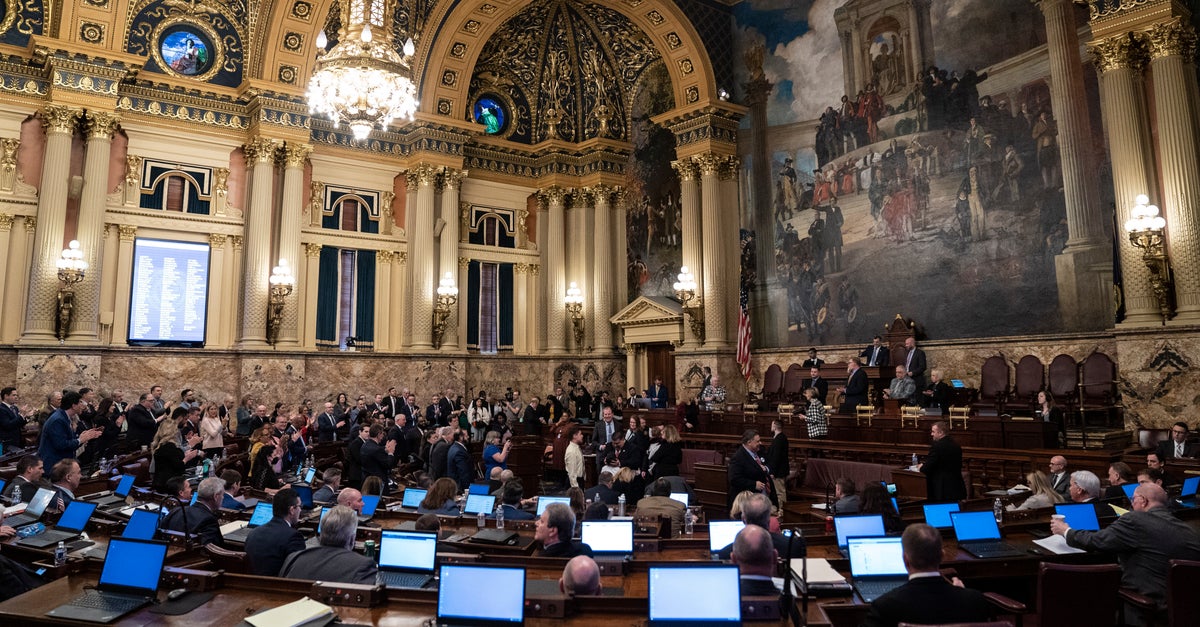Democrats at the state level are pursuing an ambitious six-year plan to control half of state legislative chambers by 2030, according to a new strategy memo released Monday and shared first with HuffPost.
The Democratic Legislative Campaign Committee, the party arm in charge of winning state-level elections, plans to dedicate roughly a third of its 2024 spending to building up power in chambers it does not expect to capture this year but could flip in future cycles.
Among its ultimate goals is to revive Democrats’ ability to wield influence during end-of-the-decade redistricting conversations. Republicans have all but dominated the process for the last decade, allowing them to severely gerrymander swing states like Michigan, Wisconsin and Pennsylvania and keep a stranglehold on power.
“State power is so incredibly important for moving the president’s agenda, for moving our party’s agenda forward,” said Heather Williams, the committee’s president. “But state legislative majorities aren’t won in a single cycle.”
The DLCC and other Democratic groups focusing on the states are playing catch-up. Republicans currently control 57 state-level chambers to Democrats’ 41, and they enjoy complete partisan control of both chambers and the governor’s mansion — known as a trifecta — in more than two dozen states. Until a few years ago, Republicans vastly outspent Democrats in state-level races. At the peak of the Redistricting Majority Project, or REDMAP — a secret, multiyear project of the GOP to dominate redistricting — Republicans controlled 68 chambers.
The DLCC’s new plan spells out the Democratic Party’s hopes to build on its far-reaching agenda for 2024. In this November’s elections, Democrats are seeking to flip multiple chambers in crucial swing states like Arizona and New Hampshire. They are also defending several new majorities and hoping to crack veto-proof majorities that Republican legislators wield in states with Democratic governors.
But another critical goal is to position Democrats to flip statehouses in future cycles. For example, in Pennsylvania, where the party narrowly controls the state’s House of Representatives, only half of the state Senate is up for reelection this year. Democrats are hoping to snatch enough seats to flip the chamber in 2026, when the other half of lawmakers are on the ballot. Other long-term targets include Wisconsin, Kansas and North Carolina.
Republican dominance of state politics has started to fracture as voters turn on some of their signature policies, like restrictions on abortion and voting rights.
In 2022, Democrats pulled off the unusual feat of defending every one of their majorities in state legislative chambers and even gaining some. Typically, the party that holds the White House loses state control.
“We’ve gotten a really nice picture of the difference between Republicans and Democrats,” Williams said. “They will introduce bills to ban books, they will introduce bills to roll back voting rights, they will introduce bills to ban abortions. … It’s a losing issue for them, and they’re on the wrong side of it.”
Michigan and Minnesota, where Democrats wrestled back full partisan control in the 2022 midterms and passed sweeping progressive agendas, have offered a stark contrast.
“You saw new trifectas who did things like pass access to free lunches in school, address family leave and child care costs and make sure workers were protected at their jobs,” Williams said. “They protected abortion. That attention to things that really matter is why Democrats in the states keep being put in positions to lead.”
The DLCC’s vision depends on its ability to meet a record fundraising goal of $60 million for this election cycle. As of January, the committee raised $21 million for this cycle. A committee spokesperson said the DLCC is raising more money so far this year than it did in 2020, and at a faster pace.
But competition for donors’ dollars and attention will become tight as U.S. congressional and presidential races heat up.
“We are telling Democrats: We can’t just keep investing in the election we’re in today,” Williams said. “There’s too much at stake, too much happening right now to have that narrow view.”

